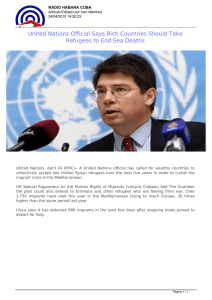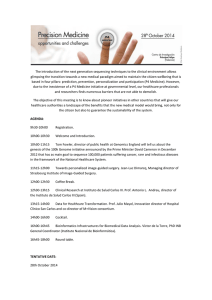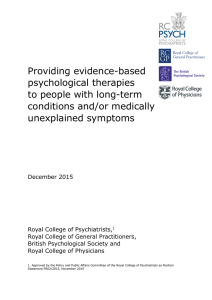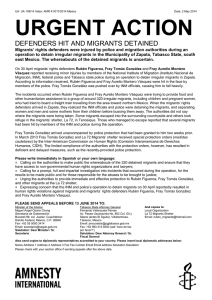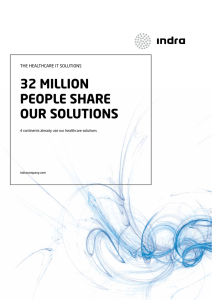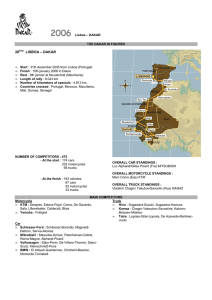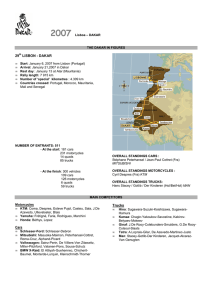Cost of exclusion from healthcare
Anuncio
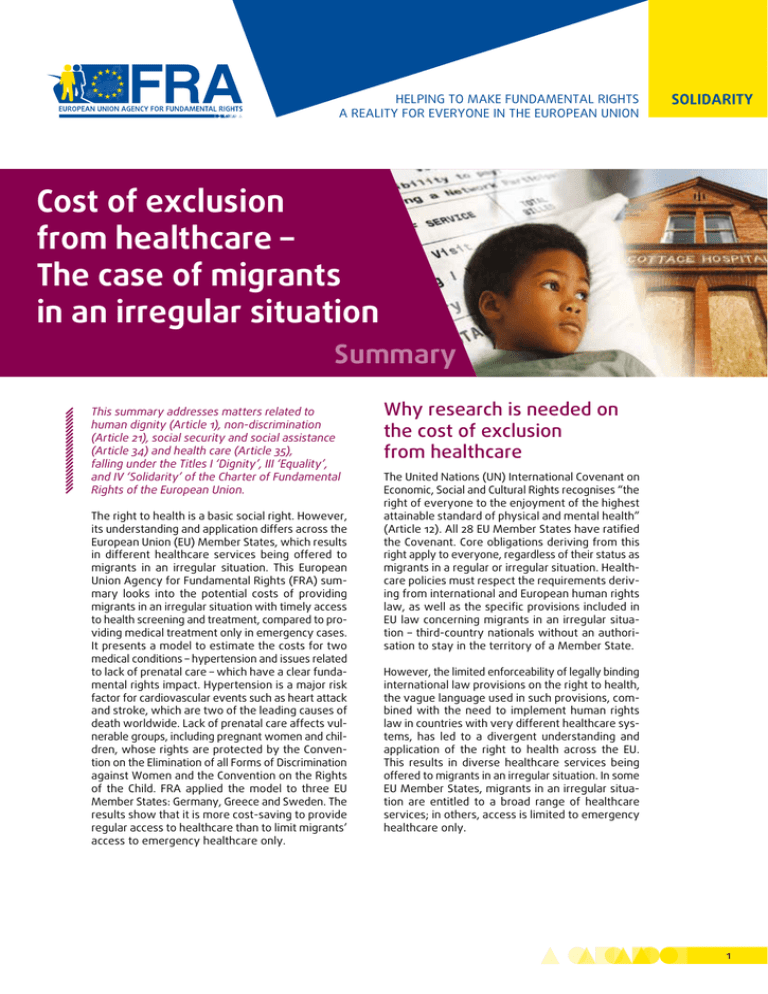
HELPING TO MAKE FUNDAMENTAL RIGHTS A REALITY FOR EVERYONE IN THE EUROPEAN UNION SOLIDARITY Cost of exclusion from healthcare – The case of migrants in an irregular situation Summary This summary addresses matters related to human dignity (Article 1), non-discrimination (Article 21), social security and social assistance (Article 34) and health care (Article 35), falling under the Titles I ‘Dignity’, III ‘Equality’, and IV ‘Solidarity’ of the Charter of Fundamental Rights of the European Union. The right to health is a basic social right. However, its understanding and application differs across the European Union (EU) Member States, which results in different healthcare services being offered to migrants in an irregular situation. This European Union Agency for Fundamental Rights (FRA) summary looks into the potential costs of providing migrants in an irregular situation with timely access to health screening and treatment, compared to providing medical treatment only in emergency cases. It presents a model to estimate the costs for two medical conditions – hypertension and issues related to lack of prenatal care – which have a clear fundamental rights impact. Hypertension is a major risk factor for cardiovascular events such as heart attack and stroke, which are two of the leading causes of death worldwide. Lack of prenatal care affects vulnerable groups, including pregnant women and children, whose rights are protected by the Convention on the Elimination of all Forms of Discrimination against Women and the Convention on the Rights of the Child. FRA applied the model to three EU Member States: Germany, Greece and Sweden. The results show that it is more cost-saving to provide regular access to healthcare than to limit migrants’ access to emergency healthcare only. Why research is needed on the cost of exclusion from healthcare The United Nations (UN) International Covenant on Economic, Social and Cultural Rights recognises “the right of everyone to the enjoyment of the highest attainable standard of physical and mental health” (Article 12). All 28 EU Member States have ratified the Covenant. Core obligations deriving from this right apply to everyone, regardless of their status as migrants in a regular or irregular situation. Healthcare policies must respect the requirements deriving from international and European human rights law, as well as the specific provisions included in EU law concerning migrants in an irregular situation – third-country nationals without an authorisation to stay in the territory of a Member State. However, the limited enforceability of legally binding international law provisions on the right to health, the vague language used in such provisions, combined with the need to implement human rights law in countries with very different healthcare systems, has led to a divergent understanding and application of the right to health across the EU. This results in diverse healthcare services being offered to migrants in an irregular situation. In some EU Member States, migrants in an irregular situation are entitled to a broad range of healthcare services; in others, access is limited to emergency healthcare only. 1 Cost of exclusion from healthcare – The case of migrants in an irregular situation Acknowledging that cost effectiveness is – next to fundamental rights and public health considerations – one of the main issues in the debate on access to necessary healthcare for migrants in an irregular situation, FRA decided to undertake desk research on the cost of exclusion from healthcare, framing this analysis within a fundamental rights perspective. Due to the absence of evidence in this area, experts and civil society organisations also called upon FRA to research the financial implications of delaying the treatment of migrants in an irregular situation in need of healthcare until the situation becomes an emergency. This summary is a first attempt to answer this call, and follows FRA’s 2011 publications on the situation of migrants in an irregular situation, which provide a detailed analysis of the right to health as it applies to persons who are not lawfully staying in a state’s territory (see the publications in the further information box). Using an economic model This summary presents an economic model to analyse and compare the costs of providing regular access to healthcare to an individual with the costs incurred if persons are not provided with such access, and as a result use more expensive emergency healthcare facilities. The economic analysis focuses on two specific clinical areas: • the provision of healthcare for patients with hypertension; • the provision of prenatal care. To better illustrate the practical application of the model, it is applied to three EU Member States: Germany, Greece and Sweden. Hypertension and prenatal care were chosen as they meet four key characteristics, which a number of other diseases did not. The factors to take into account for the selection of the medical conditions are: • the prevalence of the condition among the population of migrants in an irregular situation; • the costs that the condition generates to the healthcare system (the more significant, the more relevant from a cost-saving point of view); 2 • the extent to which the selected conditions affect particularly vulnerable groups; • the availability of data to populate the model and allow for complex analysis. Clinical evidence suggests that timely uptake of treatment for hypertension can reduce the risks of more serious cardiovascular events, such as a stroke or heart attack (myocardial infarction), which generally require emergency healthcare. Lack of prenatal care increases the risk of a child being born with low birth weight, which can have negative implications for later life. Although low birth weight can be caused by several factors, clinical evidence suggests that timely uptake of prenatal care can help identify mothers at risk of delivering a low birth weight baby. Prenatal care provides medical, nutritional and educational interventions intended to reduce the incidence of low birth weight. The economic model presented by FRA suggests the following: providing access to regular preventive healthcare to migrants in an irregular situation would not only contribute to fulfilling the right of everyone to enjoy the highest attainable standard of physical and mental health set forth in the International Covenant on Economic, Social and Cultural Rights, but would also be economically sound. Constructing the model The economic analysis is based on a ‘decision tree’ that models the effect of providing regular access to healthcare to migrants in an irregular situation who suffer from hypertension or are pregnant. This kind of model is used to represent mutually exclusive pathways where probabilities determine the likelihood of different events occurring. For example, migrants in an irregular situation can either be hypertensive or normotensive. If hypertensive, they can either be screened for the condition or not, and if screened, they can be treated for the condition or not. Similarly, a migrant woman in an irregular situation can either be pregnant or not pregnant. If pregnant, she can either access prenatal care or not access it. To construct the model, it is necessary to identify, estimate or calculate the various costs and benefits associated with each possible health outcome, and the likelihood or probability of each outcome occurring. As an illustration, Figure 1 presents the Summary hypertension conceptual framework. The model uses clinical research data to estimate the different probabilities of any of these events occurring, and the economic costs and benefits associated with any of the possible outcomes. Every attempt to source country-specific cost and benefit data was made. Where data was unavailable, FRA used proxy data (i.e. data which is a substitute for unavailable data, chosen because it is strongly related to the data of interest), particularly when estimating the costs. To make the economic analysis as countryspecific as possible, a number of health professionals and health economists in each of the three Member States validated the applicability of source data. The model assumes a healthcare perspective, which only takes direct costs borne by the health system into account and excludes indirect costs such as income loss and social benefits payable or provided to stroke and heart attack patients. This implies that, overall, the model significantly underestimates the costs to society. This in turn may provide an additional argument as to why providing access to preventive and primary care may be even more costsaving than limiting access to emergency care only. More generally, a conservative approach is taken throughout the model to ensure that the conclusions are robust, which means that the assumptions at the basis of the model tend to underestimate cost savings. The model assumes, for instance, that all hypertensive patients who are screened receive hypertension treatment until death. This is a conservative estimate, in the sense that it could lead to overestimating the costs of providing access to healthcare, as it is possible that life-style changes alone are sufficient to manage a hypertensive patient (especially a younger one) and/or that some patients do not need drugs for the remainder of their life. As a number of parameters required to elaborate the economic model are subject to uncertainty, a sensitivity analysis was performed for both conditions to check the robustness of the models. This kind of analysis is a simulation in which key parameters of the model are changed within a specific range to assess their effect on the final outcome and to predict alternative outcomes of the same course of action. A sensitivity analysis can calculate whether over or underestimating a particular cost or factor impacts on the outcome. Figure 1: Hypertension conceptual framework Screening Follow-up Normotensive No screening Migrant in an irregular situation Treatment Hypertension related outcome A&E No treament Hypertension related outcome A&E Screening Hypertensive No screening Note: Source: Hypertension related outcome A&E: Accident and emergency sector. FRA, 2015 3 Cost of exclusion from healthcare – The case of migrants in an irregular situation The model is based on the assumption that every migrant who is entitled to access regular healthcare services also uses these services in practice (100 % access). However, as patients may not always access healthcare, even when it is available, the model includes also other levels of access scenarios. The model has some limitations: first, it is a static model which does not take into account changes such as the mobility of migrants in an irregular situation who move and seek care in other EU Member States; second, where country level data was not available, proxy data were used. Thus, the costs and benefits of providing care were estimated using different approaches and sources which may introduce some bias. This was overcome, within the framework of the model, by adjusting cost data in the sensitivity analysis. The results of the model show that providing regular preventive care is cost-saving for healthcare systems when compared to providing emergency care only. This is true for hypertension as well as prenatal care. As an illustration: the age of the patient is a very relevant determinant for managing hypertension. As patients get older, the relative risk of experiencing a stroke increases, which has major human and financial implications. The impact of different age distributions among the population of migrants in an irregular situation was thus assessed in the sensitivity analysis. When taking into account different age ranges, providing regular access to care to hypertensive patients is shown to be cost saving when compared to providing no access at all. The only exception is when everyone falls within the youngest age range considered (35–44 years old), in which case providing access to care to hypertensive patients would add costs to the German and Swedish health systems (but not to the Greek one) during the first year. This is no longer the case when adopting a five-year or lifetime perspective, in which case providing access to care is cost saving in these countries and for this specific age range. Hypertension Prenatal care With respect to hypertension, assuming that all migrants in an irregular situation make regular use of preventive healthcare, after one year this would result in cost-savings of around 9 % in Germany and Greece and about 8 % in Sweden, when these costs are compared to providing emergency care only. The model also calculates costs for a timeframe of five years and over a lifetime. The cost savings increase to between 12 % and 13 % when looking at a timeframe of five years, and to about 16 % when looking at the costs of treatment over a lifetime. The results of the prenatal care model indicate that providing access to prenatal care services to migrants in an irregular situation is cost-saving. The model compares the total costs incurred under a pathway with 100 % access to prenatal care for all pregnant migrant women in an irregular situation, with a pathway where there is no access to prenatal care. After two years (the prenatal period and the year after birth, where additional costs may arise as a result of treating low birth weight), in Germany, Greece and Sweden it appears that providing prenatal care is cost-saving compared to the costs of managing additional cases of low birth weight associated with the non-provision of prenatal care. This means that the costs associated with low birth weight babies whose mothers do not receive prenatal care are higher than the costs of providing regular access to healthcare to all migrant mothers in an irregular situation. Providing regular access to healthcare is cost-saving Providing regular access to healthcare to hypertensive patients can also help to prevent future strokes and heart attacks. The results of the model show that providing access to care to hypertensive patients in Germany would prevent 344 strokes and 239 heart attacks for every 1,000 migrants over their lifetime; in Greece it would prevent 355 strokes and 222 heart attacks; and in Sweden 331 strokes and 220 heart attacks. Sensitivity analysis shows these conclusions to be robust under different scenarios and assumptions. FRA changed the following parameters in the sensitivity analysis: prevalence of hypertension 4 (assuming both higher and lower prevalence of hypertension in the population of migrants in an irregular situation), age distribution (assuming both younger and older demographic profiles of the population of migrants in an irregular situation), cost of stroke and heart attack (including lower and higher estimated costs); and probability of stroke and heart attack (estimating lower probabilities). The findings of the model suggest that providing access to prenatal care may generate savings of up to 48 % in Germany and Greece, and up to 69 % in Sweden, over the course of two years. Low birth weight cases can also be prevented through the provision of access to prenatal care, ranging from four prevented cases per 1,000 women in Germany, to five cases in Greece and six cases in Sweden. Summary Sensitivity analysis shows that these results are generally robust. FRA changed the following parameters to assess the impact on the final outcome: level of access (a scenario assuming an uptake of prenatal care services of less than 100 %); birth rates (including both an increase and decrease in the birth rate); cost of prenatal care (including both an increase and decrease in the cost of delivering prenatal care); cost of low birth weight (including both an increase and decrease in the costs associated with low birth weight); and probability of low birth weight (various scenarios where the probability of low birth weight with no prenatal care provided decreased). For example, using the pregnancy rates of the host countries might have resulted in a wrong estimation of the number of pregnancies among the population of migrants in an irregular situation. Hence, this parameter was varied in the sensitivity analysis. When using the higher than average birth rates of the countries of origin of migrants in an irregular situation (instead of those of the host countries), the results show that as the number of pregnant women increases, so do the overall cost savings in Sweden, Greece and Germany. Economic considerations Although economic considerations must be applied cautiously and cannot be used to justify a lack of compliance with fundamental rights, together with public health considerations, cost effectiveness is one important issue in the debate on access to healthcare for migrants in an irregular situation. The results of testing the economic model are a conservative but powerful indication that governments would save money by providing access to primary healthcare to migrants in an irregular situation in the case of hypertension and prenatal care. Even when several parameters are changed, testing the model under varying costs still tends to show that provision of access to regular preventive care is economically preferable to more expensive emergency care treatment. Whereas this analysis focuses only on healthcare cost-savings, the evidence suggests that avoiding conditions associated with hypertension and lack of prenatal care generates wider benefits. Due to its potential long-term consequences, stroke has been known to create considerable social and economic burdens on individuals and society; low birth weight, especially for babies in the lower weight categories, can have lifetime consequences, such as cerebral palsy, vision loss or for the less extreme cases it can, for example, affect school performance. All these outcomes have a serious impact on quality of life. Even though these wider benefits are not included in the present economic analysis, a very strong case can be made to take them into consideration when evaluating the benefits of preventive measures, such as providing access to hypertension treatment and prenatal care. Migrants in an irregular situation are not the only group of persons who, either as a result of absence of health insurance or for other reasons, are barred from accessing healthcare services beyond emergency treatment. The economic model presented by FRA could also be a starting point to develop a cost analysis for other categories of persons deprived of regular access to healthcare. 5 Cost of exclusion from healthcare – The case of migrants in an irregular situation Conclusions • The right to health is a basic social right protected in international and European human rights law. Core obligations deriving from this right apply to everyone, regardless of their status as migrants in a regular or irregular situation. • FRA’s analysis shows that providing timely access to health screening and treatment not only contributes to fulfilling the right of everyone to enjoy the highest attainable standard of physical and mental health set forth in the International Covenant on Economic, Social and Cultural Rights, but is also cost-saving compared to providing medical treatment only in emergency cases. • As already concluded in FRA’s report Migrants in an irregular situation: Access to healthcare in 6 10 European Union Member States, provision of healthcare to migrants in an irregular situation in EU Member States should not be limited to emergency care only, but should also include other forms of essential healthcare, such as the possibility to see a doctor and to receive necessary medicines. Women in an irregular situation should have access to the necessary primary and secondary healthcare service in case of delivery, as well as to reproductive and maternal healthcare services, at the same level as nationals. These should include primary and secondary ante- and post‑natal care, such as the possibility to visit a gynaecologist and access essential tests, family planning assistance or counselling. The right to health is a basic social right. However, its understanding and application differs across the European Union (EU) Member States, which results in different healthcare services being offered to migrants in an irregular situation. This European Union Agency for Fundamental Rights (FRA) summary looks into the potential costs of providing migrants in an irregular situation with timely access to health screening and treatment, compared to providing medical treatment only in emergency cases. It presents a model to calculate the costs for two medical conditions: hypertension and prenatal care. FRA applied the model to three EU Member States: Germany, Greece and Sweden. Although results must be interpreted with caution, the testing shows that providing access to regular preventive healthcare for migrants in an irregular situation would be cost-saving for healthcare systems. Treating a condition only when it becomes an emergency not only endangers the health of a patient, but also results in a greater economic burden to healthcare systems. Further information: For the full report, Cost of exclusion from healthcare – The case of migrants in an irregular situation, see http://fra.europa.eu/en/publication/2015/cost-exclusion-healthcare. The following FRA publications offer further information on the situation of migrants in an irregular situation: • Migrants in an irregular situation: Access to healthcare in 10 European Union Member States (2011), http://fra.europa.eu/en/publication/2012/migrants-irregular-situation-accesshealthcare-10-european-union-member-states • Fundamental rights of migrants in an irregular situation in the European Union (2011), http://fra.europa.eu/en/publication/2012/fundamental-rights-migrantsirregular-situation-european-union • Criminalisation of migrants in an irregular situation and of persons engaging with them (2014), http://fra.europa.eu/en/publication/2014/criminalisation-migrants-irregularsituation-and-persons-engaging-them For an overview of FRA activities on asylum, migration and borders, see http://fra.europa.eu/en/theme/ asylum-migration-borders. Schwarzenbergplatz 11 – 1040 Vienna – Austria Tel. +43 158030-0 – Fax +43 158030-699 fra.europa.eu – info@fra.europa.eu facebook.com/fundamentalrights linkedin.com/company/eu‑fundamental‑rights‑agency twitter.com/EURightsAgency Print: ISBN 978-92-9239-945-0, doi:10.2811/029415 PDF: ISBN 978-92-9239-946-7, doi:10.2811/825284 TK-01-15-563-EN-C (print); TK-01-15-563-EN-N (PDF) FRA – EUROPEAN UNION AGENCY FOR FUNDAMENTAL RIGHTS © European Union Agency for Fundamental Rights, 2015 Photo (Cover): © iStockphoto
